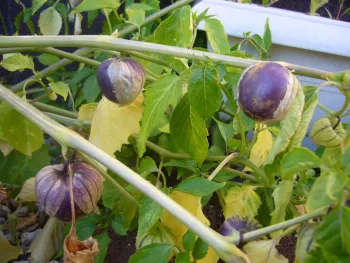Scientific Name

Physalis ixocarpa
General Information
Tomatillos are a warm season crop with growing requirements similar to tomatoes. The small, tomato-like fruit develops in lantern-like paper husks. Tomatillos are used in cooking and in salsas. They belong to the nightshade (Solanaceae) family.
Planting
When to Plant
Plant after danger of frost is past and soil has warmed, April through June.
Can be started indoors from seed – six weeks before last frost date. Plant in a location with full sunlight (at least six hours a day). When planting seedlings, pinch off lower leaves and bury half of the plant below the soil line to encourage root growth from the stem. Space plants about two feet apart. Plants grow to four feet tall -- use a cage or stake for support.
Soil Requirements
Plant in loose, light, well-drained soil. A few weeks prior to planting, test soil and add compost and nutritional amendments. If nutrients are indicated, use a mid-value, balanced fertilizer or add individual amendments to boost N-P-K as needed. Plants prefer neutral soil, with a pH between 5.5 and 7.3.
Water Requirements
Watering needs are similar to those of tomatoes. Water newly transplanted tomatillos twice a week. Once young plants are established, water several times per week and up to daily when temperatures are high and plants are large. As with tomatoes, once fruit has set and harvest is near, reduce irrigation. Mulch plants to help retain soil moisture.
Fertilizing
Tomatillos require moderate fertilization. Too much nitrogen will cause excess leaf growth.
Pollination
Tomatillos are not self-pollinating, but they are also cross-pollinating. For best results, grow at least two plants of the same variety close to one another, offering bees and other insects many opportunities to pollinate the flowers.
Harvesting
Tomatillos are ready to harvest when the papery husk splits open (or turns brown and leathery). Best to cut fruit from the plant, rather than pull it, which might damage the stem. Harvest before green fruit turns yellow (when it will be overripe).
Storage
May be stored at room temperature for up to one week, but better to keep cool in the refrigerator in a paper bag, not plastic, for up to three weeks. Can be frozen or preserved by canning, often for salsa.
Good Varieties for Marin
- ‘Tomate' or 'Toma Verde’ (green)
- 'De Milpa' (purple)
Helpful Tips
Plants can sprawl, so stake or cage young plants to provide support and keep fruit from the ground, or trim back. Remove plants after harvest.
Pests- Diseases & More
Tomatillos have few pests. They can be affected by Tobacco mosaic virus, tomato yellow leaf curl virus, and turnip mosaic virus (transmitted by aphids).

